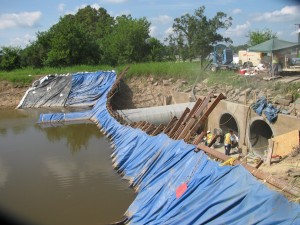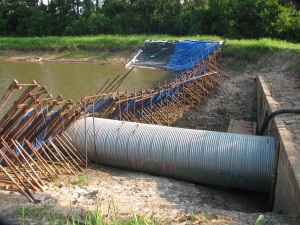June 2011 Vol. 66 No. 6
Features
When Size Matters: CCCP Solution For Large Inverted Siphons Rehab

The Sabine River Authority (SRA) of Texas was created in 1949 to equitably distribute the waters of the Sabine River and its tributaries. As part of this distribution, “We provide surface water to eleven industrial customers, such as Conoco and Louisiana Pigment, for cooling and processing,” says SRA Facility Manager Mike Carr.
This water is conveyed mostly via a 35-mile long open canal. But where that canal must cross under roadways and railroad tracks, the water passes through inverted siphons.
The siphons are made from reinforced concrete pipe that is typically used in storm sewers and other low pressure applications. But the siphons are usually full and, with wear and movement over time, leaks and structural cracks have occurred.
“Most of this concrete pipe went in back in the ’70s,” explains Carr, “and now we’re seeing broken lips at the joints, a lot of leakage, and sediment is getting into the water and compromising quality. Also, the possibility of collapse at the crossings is a danger to the public and the railways. When we see problems, we have to fix them.”

The Authority is systematically rehabilitating all 40 siphon crossings in its network. The preferred method is cured in place pipe (CIPP) and SRA has a long history with this method. But CIPP hasn’t worked well in large diameter pipe for the SRA.
Two crossings in particular were problematic. One was a roadway crossing with three 84-inch diameter siphons running parallel for 180 feet. The other was a railroad crossing with two 78-inch siphons running parallel for 185 feet. Both were bid for CIPP.
“We’ve used linings before with a lot of success, but that was mainly on pipes up to 42-inches,” explains Carr. “We tried to use cured linings on pipe this size and ran into problems.”
Bad experience
In fact, the first attempt at cured-in-place lining one of the 78-inch siphons was a disaster as the lining collapsed and had to be cut out and removed. A second attempt was successful, but not totally satisfactory. There was visible sagging at siphon ends, and the Authority was uneasy about structural integrity. Carr asked the project engineer, Meyer & Associates, to look into alternatives. The contractor, Boh Brothers Construction Company, also wanted an alternative for the larger diameter siphons, and suggested CentriPipe, a centrifugally cast lining solution used by one of their associated firms, Repipe-Texas. CentriPipe turned out to be a successful alternative for these troublesome large-diameter crossings.
It’s important to keep in mind that several factors — size, heat, equipment availability and staging area requirements — combined to make CIPP impractical on this project. “Linings this big can be installed,” explains Meyer & Associates Project Manager Wayne Harris, P.E., “but the necessary equipment is hard to find and lease — there just aren’t that many set-ups available.”
Harris says that heat was a major factor. “It was the middle of July when it’s very hot, and it was extremely difficult to keep the lining cool until it was in place and ready to be cured.” Staging, too, was a consideration. For linings this size, several cranes are needed along with other bulky equipment, which means that very large pads are needed at both ends of the siphons. Sometimes, the necessary space simply isn’t available.
For all these reasons plus the fact that CIPP is proportionally more expensive at larger diameters, Harris realized that there were very good reasons to look into CentriPipe. If it could overcome the challenges that made cured lining impractical, it could solve a very real problem for the Sabine River Authority.
Centrifugally cast concrete pipe
CentriPipe, from AP/M Permaform, is a process also known as centrifugally cast concrete pipe (CCCP). This system was initially developed for manhole rehabilitation and other vertical uses, but improvements in materials and casting control have made CCCP effective for large horizontal pipes. For example, the Florida Department of Transportation has used CentriPipe to line a 13-foot diameter culvert near Jacksonville, FL.
Basically, the CentriPipe system uses an automated retrieval system and spincaster to apply thin, precisely-calculated layers of high strength cementitious grout to pipe interiors. The spincaster is inserted into the pipe and pulled back slowly as the structural liner is applied.
The cementitious grout applied was PL-8000 from AP/M Permaform. PL-8000 is a fiber reinforced high-strength cementitious grout that can be mixed onsite and used with the CentriPipe spincaster. It can be applied to most substrates (brick, concrete, metal, etc.) and it is waterproof, corrosion-resistant and structurally sound even in relatively thin layers. It also adheres extremely well, even when the substrate is damp as was the case with the SRA siphons. Since flows were active in the parallel siphons while the by-passed siphons were being repaired, serious infiltration from the saturated soils was occurring.

The finished thickness was calculated according to projected loads, and the minimum thickness was determined to be two-inches. SRA opted for 2.75-inch thickness under the railway crossing as a hedge against heavier loads and vibration. These thicknesses were applied in five full-length, continuous passes.
Despite the multiple passes, CCCP was still efficient compared to CIPP. “On the 78-inch crossing — which was two, basically identical, siphons — we did one with CIPP and one with CentriPipe,” Harris explains, “It’s hard to compare precisely, because there was a learning curve with both processes, but I’d say the CentriPipe was faster.”
Cost comparisons are also favorable. For larger diameter pipe, CentriPipe clearly cost less per foot than CIPP. “We also considered spot repairing as an option, and that would have cost less than either CIPP or CentriPipe,” Harris says, “But if we’d done that, we wouldn’t have ended up with a fully lined pipe.”
By being open to a relatively new infrastructure solution, Sabine River Authority ended up with fully rehabilitated pipes that are smooth, structurally sound, and completely sealed with minimal flow disruption during the procedure. Carr is still waiting to see how CentriPipe performs in the long run, but is very satisfied with the initial results.
About the author: Angus W. Stocking, L.S. is a licensed land surveyor who writes full-time on infrastructure topics. He can be reached at www.InfrastructureWriting.com.
FOR MORE INFO:
AP/M Permaform, (515) 276-9610, http://permaform.net/site/
Boh Bros. Construction Co., (800) 284-3377, www.bohbros.com
Meyer & Associates Inc., (337) 625-8353, http://meyerassociates.com




Comments